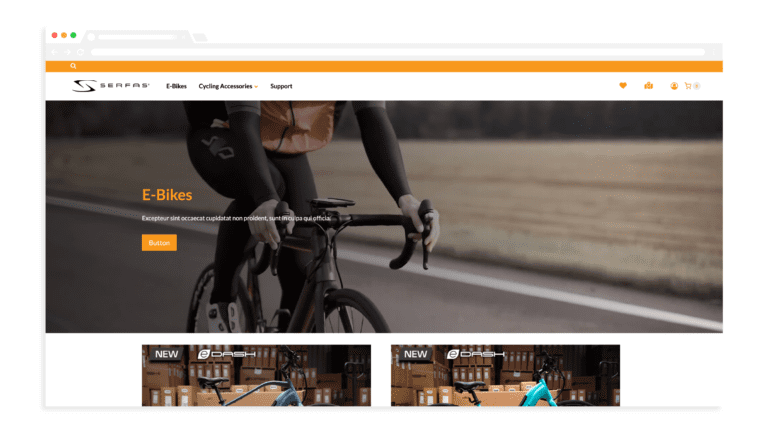

Now that we’re on our last article in the series, Creatitive has decided to add one last secret ingredient to the mix. In our previous piece on social media in sports marketing, we briefly discussed the bigger catch that almost everyone in the market is chasing after; omnichannel marketing success.
It’s often the result of veteran athletes maintaining great relationships with fans and taking care of their brand personality for years! And as we’ve mentioned in our very first guide on how to market an athlete, things have changed.
Omnichannel success is not easy to achieve — it involves a lot of planning and constant observation to ensure everything is cohesive with one another. One mistake can easily cost you a branding strategy, but luckily you have us! And as we wrap up our guide, we’ll be adding one extra tip for good luck.
So before we proceed with that one secret ingredient, let’s first take a refresher!
The Power of an Athlete’s Fulfilling Story
Aside from bridging brands and consumers to a more meaningful connection, a compelling brand story makes omnichannel success much more feasible. As we’ve mentioned throughout this series, consistency matters to branding.


Have you ever wondered why after how many decades Michael Jordan is still a household name in basketball conversations? Or even after reaching his peak, Pacquiao still sells tickets? Even Serena Williams became more than just a great tennis player, especially for women. That is because they all have fulfilling stories to tell. Sports fans, and people in general, are bonded by great stories. There is even an industry whose role is to tell stories, yes the entertainment and media industry. But what makes sports and athlete stories even more powerful? Because they are stories of real people who achieved greatness.
And with one cohesive brand storytelling, you’ll have a much easier time pulling it off. Craft a narrative that defines your brand, one that simply points out your history, your offers, and your experience in the industry. It’s a more impactful approach rather than just stating points!
Aside from this, it has the ability to showcase the value of a brand — just take a look at testimonials and customer case studies! This is another part of your brand story that further solidifies its credibility through social proof.
Instead of just sticking with normal paperback strategies, your brand will be introducing itself through a fluid and great story on each of its platforms. Not only will it improve the customer’s journey as they familiarize themselves with your brand, but it also provides you with a much easier strategy to keep things consistent!
The Ultimate Guide on How to Market An Athlete
To sum things up from our previous blog posts, Creatitive has categorized the process of creating a brand that just makes sense into three major levels; develop, market, and promote. Here is a refresher with this ultimate guide!
Explore Through Self-Discovery and Develop Strategies
Going back to the very first part of this series, branding starts with research. It starts with knowing whose hero you’ll be. Think about the people you want your brand to serve and get to know them better — how else will you be able to connect with them without knowing them first?
Don’t be afraid to take your time knowing your target market. One of the most common culprits behind failed brands is inadequate research. They don’t know the needs and wants of their people, so they end up falling short in their efforts. The customer profiles you’ll be able to gather during this time will help you develop products and services that will serve them well.


Once you get to know them better, you’re likely to have a better idea of which platform they spend most of their time in. If your audience spends much of their time on Twitter, prioritize learning how to use that platform first. But regardless of their favorite social media network, creating accounts on each one is a good rule of thumb.
This is because it allows you to tap into more of your consumers. Those in your audience that don’t have Twitter can easily reach out to you through Facebook. Once you’re done creating your social media accounts, you can now focus on your website!
Amongst all the platforms that you have, your website is the most important one. Why? Because regardless of the amount of time people spend on social media, search engines are still their go-to for information.
For example, if they want to look for a certain product, they often use Google for searching. And if you’ve equipped your site with an effective SEO campaign, you’ll surely have a higher rank — but more on this later.
With the skeleton of your brand all good to go, you can now go and work on your brand identity and your brand language! To recap, your brand’s identity is its visual elements — meaning your logo, typeface, and design. And to reiterate, both should be cohesive with one another.
Inconsistency creates a discrepancy between who you are as a brand and who people see you as. Your visual cues should reflect your values while being eye-catching enough to stand out. The same thing applies to your brand language, it shouldn’t alienate your consumers.
Execute All Details and Start Marketing!
Now that we’ve successfully developed a brand, you can now start planning your marketing strategies!
As mentioned earlier, a website is a brand’s most important platform — hence, it only makes sense that their marketing strategies push for organic searches first. Before jumping into an SEO campaign, make sure that your site is all prepared and ready.
If you’re yet to create one, don’t be afraid to seek out the professional help of a web development company! They can guide you through a web discovery session, which increases the chances of an effective site.
But in case your site has all the fundamentals it needs to support the campaign, you can start planning your campaign by initiating keyword research. List down the terms your competitors are currently ranking in and combine them with your targeted keywords.
Keep in mind that the success of your campaign lies in the right phrases and their strategic use, so don’t be afraid to spend as much time as you can on them! Once you’ve finalized all of your keywords, you start working on your content marketing tactics.
To reiterate, content is king for digital marketing. Authentic, creative, and meaningful content. A large number of marketers believe that blogging is a great way to improve both brand awareness and engagement. Invest in creating engaging content and make sure that the right audience is reading them!


By learning the ropes of increasing organic search, brands will have a better idea of leveraging paid marketing. Unlike the common misconception that PPC ads and SEO campaigns should be implemented separately, they actually mix well together! Pay-per-click allows you to see other opportunities for your strategies while the latter serves as your constant source of traffic.
Once the base of your digital marketing campaign is done, you can start working on your social media accounts. Now while your website is hailed as your most important tool, it doesn’t mean your social media means less. As a matter of fact, it can help further strengthen what your site has already built.
At this stage, your brand must have figured out the preferred platform of your consumers. If most of your target audience spends most of their time scrolling through Instagram, then your brand must be there too.
Use the brand guidelines you’ve created during the development stage of your brand, craft a compelling narrative on your posts! Storytelling has played a big role in the success of many companies today, why? We’ll discuss that one later. But in the meantime, how can you ensure it grabs the attention of your people?
Use your brand language so that consumers can easily relate to you! Leverage your existing fanbase in order to improve the current engagement count of your social media accounts. Don’t be afraid to invest in building a solid following there — why, you ask?
Customer engagement and followers matter most, and not just in terms of sales or brand awareness. Say, for instance, you wanted to launch a crowdsourcing campaign for funding. A solid online presence instantly becomes irresistible for companies and sponsors.
As we’ve mentioned in our first article in the series, they are companies hoping to tap into new audiences. And one of the most common ways of doing this is by working with brands who have a steady following themselves. Leverage your existing followers and engagement count for your funding!
And once you’ve covered the base of your brand and marketing a brand, you can start planning on how you’ll catch the bigger fish; Omnichannel Marketing!
Promote it to the World
Our recent piece on the series briefly discussed what omnichannel marketing is and why it matters. But today, we’ll be making a nosedive into what it is and the one secret ingredient it takes to win it!


As mentioned earlier, omnichannel marketing is the process of curating a seamless experience for customers. It means allowing them to switch from their phones to their laptops without any problems — and unbeknownst to many, this factor matters more than anything else.
Recent studies from Google states that 98% of Americans switch from one device to another in a single day. And as a result, they expect a seamless transition from their phones to their laptops. Another research that further supports this claim has revealed that 89% of businesses with omnichannel marketing retained more customers when compared to those who don’t.
Multichannel Vs Omnichannel
If you’ve mixed up omnichannel with multichannel — that’s totally understandable. Frankly speaking, newer business owners will have a hard time separating one from the other as they awfully sound alike.
To make things easier, we’ve listed down three major differences to keep in mind!
Consumers Over Channels
One major difference between the two is their approach. While omnichannel prioritizes consumer experience, multichannel focus on channels. It wants to get the message on every possible channel out there. It’s like casting the largest net at sea to catch the most fish.
On the other hand, the omnichannel approach focuses on whether the consumer is having fun or not. It wants to build a holistic experience for audiences so that their relationship with them stays solid and strong.
Consistency Over Engagement
With consumers first in mind, omnichannel strategies are diligent in ensuring they receive the same experience and messaging in every possible channel. While they still value engagement as much as multichannel approaches do, they prioritize uniformity in every piece of content they release.
Because again, they want to take good care of their relationship with the target audience.
Efforts Over Effortless
Omnichannel hopes to make a customer’s experience as effortless as possible. It uses the data it has gathered from its target audiences to build a shopping experience that doesn’t require them to do much — even if they change devices.
In a nutshell, taking on an omnichannel strategy means investing in the relationships businesses have built with their consumers. It means crafting a connection that’s beneficial for both parties!
The Secret Ingredient in Knowing Your Brand Story?
Now that we’ve already covered the fact that achieving omnichannel success is relatively harder than most people think, let’s talk about how we can overcome that obstacle with one secret ingredient; storytelling! It is not just about writing prompts that make sense or a story that sounds true. It’s all about self-expression, creative, and meaningful life. It’s all about athletes living their most authentic lives.


The idea of sharing a story through marketing strategies was briefly mentioned earlier when we were discussing social media management — and it is expected. Much of the advertisements and other strategies and tactics we see online and offline share a narrative that consumers can relate to. You can write a new approach about an athlete’s personal grief, loss, and struggles. Somehow a journal approach, and you will realize the power of stories that people will relate to.
But you’re probably thinking, why a great brand story? Well, it checks off two important things to omnichannel success; personalization and engagement. Brands craft a story that’s relevant to the consumers — one that feels like it personalizes their needs. And as a result, consumers are more compelled to interact with them in hopes of earning a sense of belongingness!
Collaborate with a Storyteller and Branding Expert Today
Ultimately, building a brand is much like raising a child — it takes an entire village to succeed. But at the end of the day, just like every team’s greatest effort, it’s more than just rewarding.
If you’re hoping to find your village of marketing professionals and web designers, don’t be shy to hit us up! Creatitive is more than willing to be the village of your dreams — the team that will lead your brand to its greatest victory!
Is anyone ready to begin to write a new and deeply personal athlete story? Let’s go!
Related Articles
How to Market an Athlete part 1 (Building a Brand)
How To Market an Athlete part 2 (Developing a Logo)
How To Market an Athlete part 3 (Website Development)







